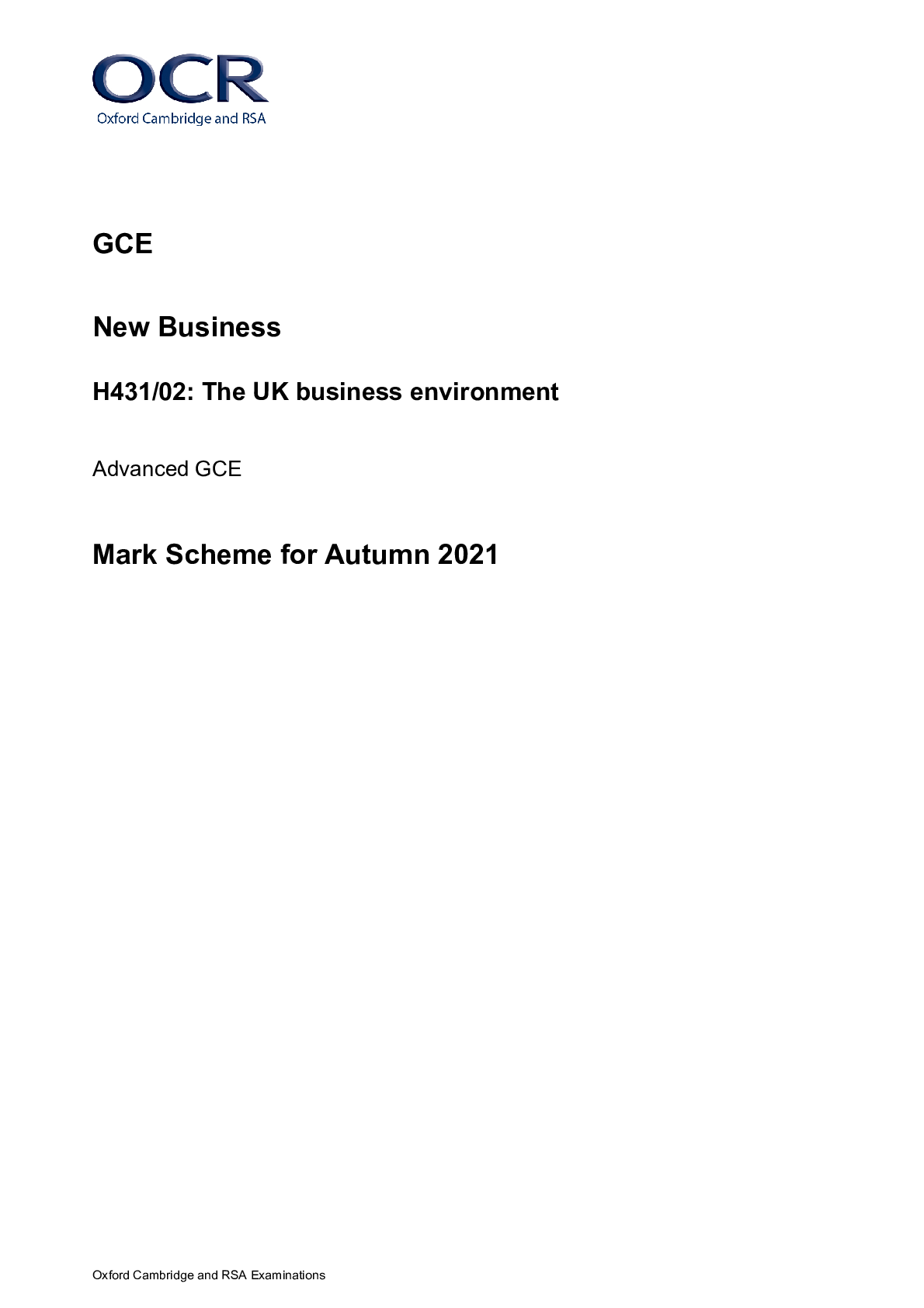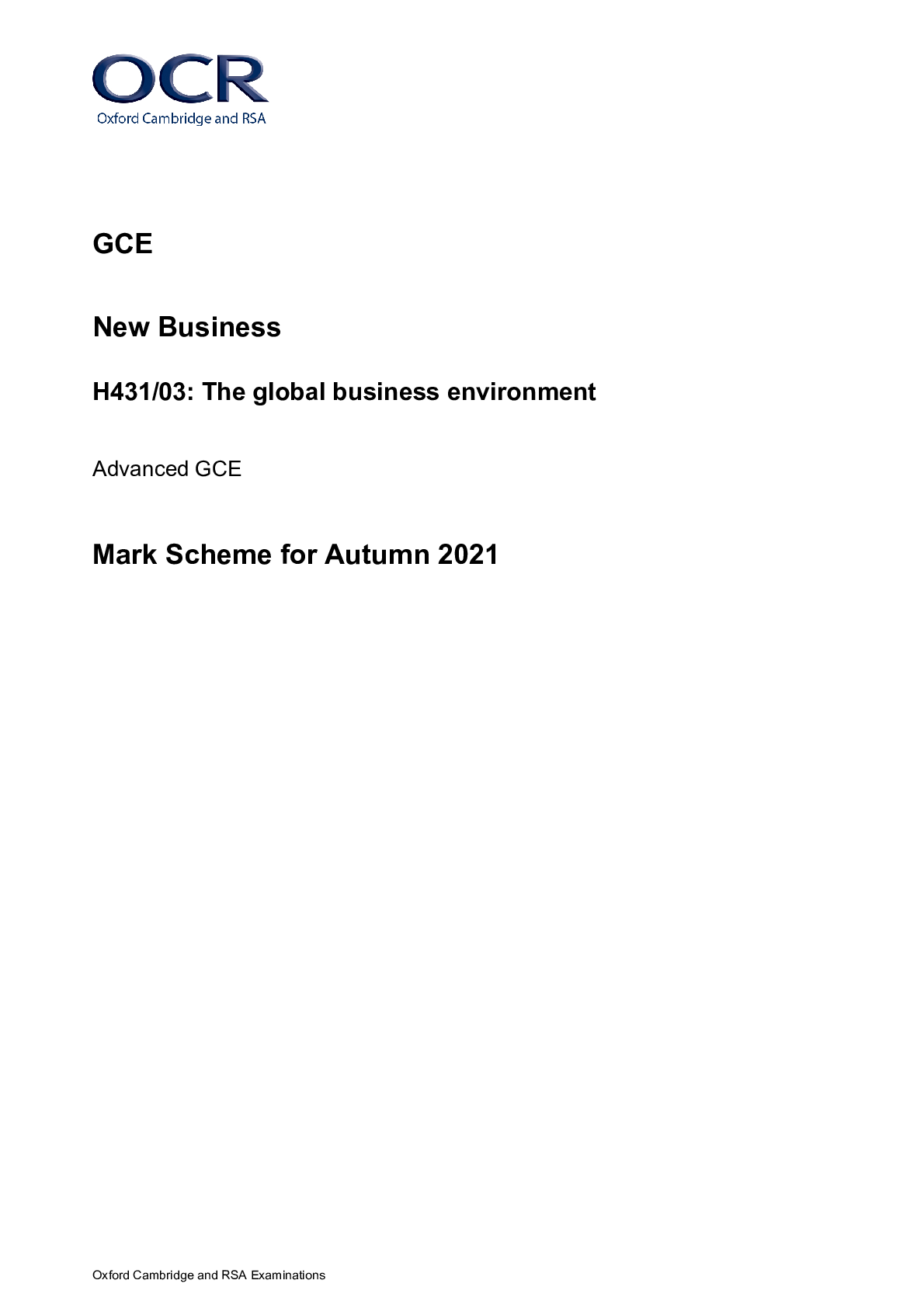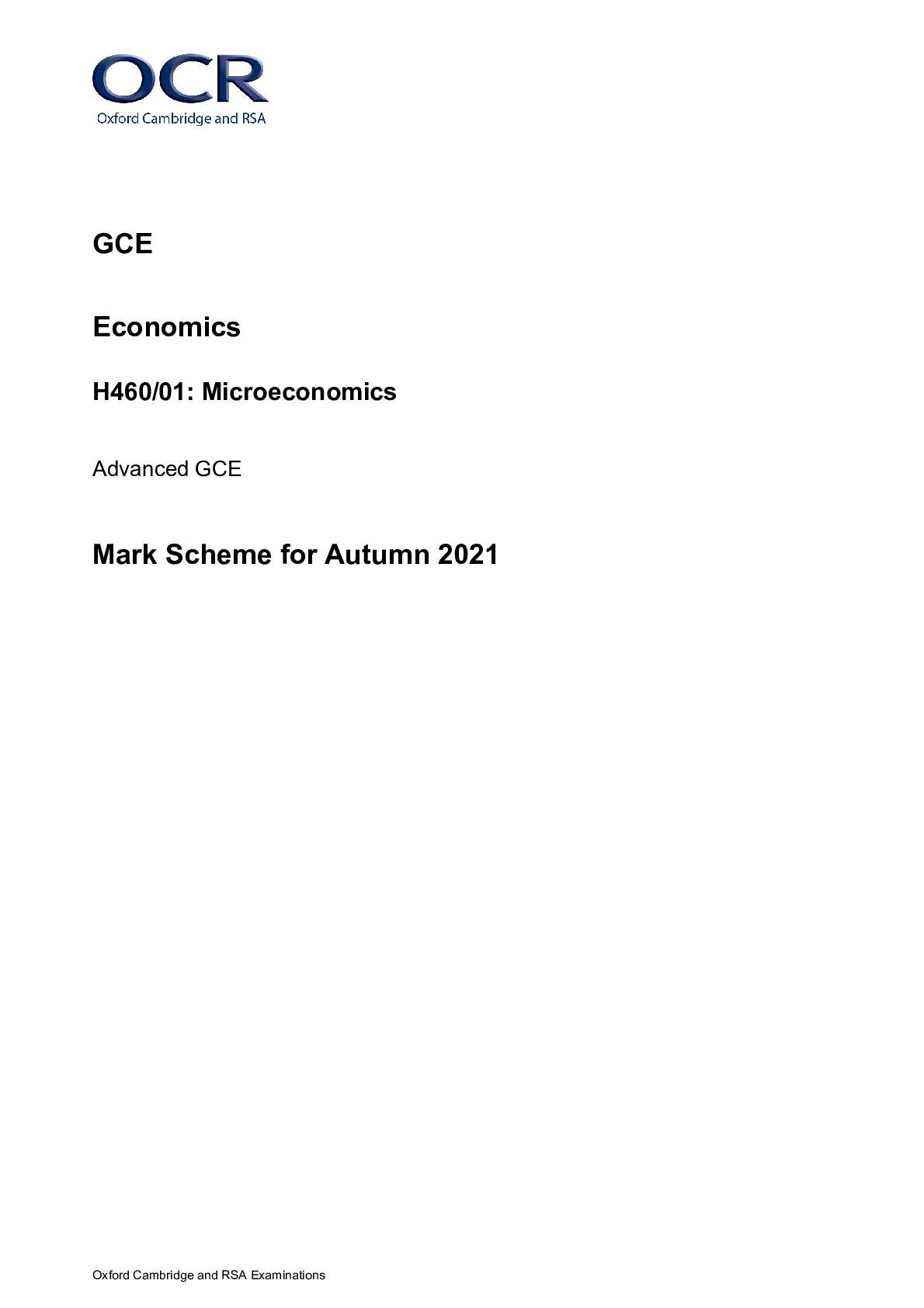Mathematics > MARK SCHEME > GCE Mathematics A H230/02: Pure Mathematics and Mechanics Advanced Subsidiary GCE Mark Scheme for No (All)
GCE Mathematics A H230/02: Pure Mathematics and Mechanics Advanced Subsidiary GCE Mark Scheme for November 2020
Document Content and Description Below
GCE Mathematics A H230/02: Pure Mathematics and Mechanics Advanced Subsidiary GCE Mark Scheme for November 2020 Oxford Cambridge and RSA Examinations GCE Mathematics A H230/02: Pure Mathemat... ics and Mechanics Advanced Subsidiary GCE Mark Scheme for November 2020Oxford Cambridge and RSA Examinations OCR (Oxford Cambridge and RSA) is a leading UK awarding body, providing a wide range of qualifications to meet the needs of candidates of all ages and abilities. OCR qualifications include AS/A Levels, Diplomas, GCSEs, Cambridge Nationals, Cambridge Technicals, Functional Skills, Key Skills, Entry Level qualifications, NVQs and vocational qualifications in areas such as IT, business, languages, teaching/training, administration and secretarial skills. It is also responsible for developing new specifications to meet national requirements and the needs of students and teachers. OCR is a not-for-profit organisation; any surplus made is invested back into the establishment to help towards the development of qualifications and support, which keep pace with the changing needs of today’s society. This mark scheme is published as an aid to teachers and students, to indicate the requirements of the examination. It shows the basis on which marks were awarded by examiners. It does not indicate the details of the discussions which took place at an examiners’ meeting before marking commenced. All examiners are instructed that alternative correct answers and unexpected approaches in candidates’ scripts must be given marks that fairly reflect the relevant knowledge and skills demonstrated. Mark schemes should be read in conjunction with the published question papers and the report on the examination. © OCR 2020H230/02 Mark Scheme November 2020 2 Text Instructions 1. Annotations and abbreviations Annotation in RM assessor Meaning and BOD Benefit of doubt FT Follow through ISW Ignore subsequent working M0, M1 Method mark awarded 0, 1 A0, A1 Accuracy mark awarded 0, 1 B0, B1 Independent mark awarded 0, 1 SC Special case ^ Omission sign MR Misread BP Blank Page Seen Highlighting Other abbreviations in mark scheme Meaning dep* Mark dependent on a previous mark, indicated by *. The * may be omitted if only one previous M mark cao Correct answer only oe Or equivalent rot Rounded or truncated soi Seen or implied www Without wrong working AG Answer given awrt Anything which rounds to BC By Calculator DR This question included the instruction: In this question you must show detailed reasoning.H230/02 Mark Scheme November 2020 3 2. Subject-specific Marking Instructions for A Level Mathematics A a Annotations must be used during your marking. For a response awarded zero (or full) marks a single appropriate annotation (cross, tick, M0 or ^) is sufficient, but not required. For responses that are not awarded either 0 or full marks, you must make it clear how you have arrived at the mark you have awarded and all responses must have enough annotation for a reviewer to decide if the mark awarded is correct without having to mark it independently. It is vital that you annotate standardisation scripts fully to show how the marks have been awarded. Award NR (No Response) - if there is nothing written at all in the answer space and no attempt elsewhere in the script - OR if there is a comment which does not in any way relate to the question (e.g. ‘can’t do’, ‘don’t know’) - OR if there is a mark (e.g. a dash, a question mark, a picture) which isn’t an attempt at the question. Note: Award 0 marks only for an attempt that earns no credit (including copying out the question). If a candidate uses the answer space for one question to answer another, for example using the space for 8(b) to answer 8(a), then give benefit of doubt unless it is ambiguous for which part it is intended. b An element of professional judgement is required in the marking of any written paper. Remember that the mark scheme is designed to assist in marking incorrect solutions. Correct solutions leading to correct answers are awarded full marks but work must not always be judged on the answer alone, and answers that are given in the question, especially, must be validly obtained; key steps in the working must always be looked at and anything unfamiliar must be investigated thoroughly. Correct but unfamiliar or unexpected methods are often signalled by a correct result following an apparently incorrect method. Such work must be carefully assessed. When a candidate adopts a method which does not correspond to the mark scheme, escalate the question to your Team Leader who will decide on a course of action with the Principal Examiner. If you are in any doubt whatsoever you should contact your Team Leader.H230/02 Mark Scheme November 2020 4 c The following types of marks are available. M A suitable method has been selected and applied in a manner which shows that the method is essentially understood. Method marks are not usually lost for numerical errors, algebraic slips or errors in units. However, it is not usually sufficient for a candidate just to indicate an intention of using some method or just to quote a formula; the formula or idea must be applied to the specific problem in hand, e.g. by substituting the relevant quantities into the formula. In some cases the nature of the errors allowed for the award of an M mark may be specified. A method mark may usually be implied by a correct answer unless the question includes the DR statement, the command words “Determine” or “Show that”, or some other indication that the method must be given explicitly. A Accuracy mark, awarded for a correct answer or intermediate step correctly obtained. Accuracy marks cannot be given unless the associated Method mark is earned (or implied). Therefore M0 A1 cannot ever be awarded. B Mark for a correct result or statement independent of Method marks. Unless otherwise indicated, marks once gained cannot subsequently be lost, e.g. wrong working following a correct form of answer is ignored. Sometimes this is reinforced in the mark scheme by the abbreviation isw. However, this would not apply to a case where a candidate passes through the correct answer as part of a wrong argument. d When a part of a question has two or more ‘method’ steps, the M marks are in principle independent unless the scheme specifically says otherwise; and similarly where there are several B marks allocated. (The notation ‘dep*’ is used to indicate that a particular mark is dependent on an earlier, asterisked, mark in the scheme.) Of course, in practice it may happen that when a candidate has once gone wrong in a part of a question, the work from there on is worthless so that no more marks can sensibly be given. On the other hand, when two or more steps are successfully run together by the candidate, the earlier marks are implied and full credit must be given. e The abbreviation FT implies that the A or B mark indicated is allowed for work correctly following on from previously incorrect results. Otherwise, A and B marks are given for correct work only – differences in notation are of course permitted. A (accuracy) marks are not given for answers obtained from incorrect working. When A or B marks are awarded for work at an intermediate stage of a solution, there may be various alternatives that are equally acceptable. In such cases, what is acceptable will be detailed in the mark scheme. If this is not the case please, escalate the question to your Team Leader who will decide on a course of action with the Principal Examiner. Sometimes the answer to one part of a question is used in a later part of the same question. In this case, A marks will often be ‘follow through’. In such cases you must ensure that you refer back to the answer of the previous part question even if this is not shown within the image zone. You may find it easier to mark follow through questions candidate-by-candidate rather than question-by-question. f We are usually quite flexible about the accuracy to which the final answer is expressed; over-specification is usually only penalised where the scheme explicitly says so. • When a value is given in the paper only accept an answer correct to at least as many significant figures as the given value.H230/02 Mark Scheme November 2020 5 • When a value is not given in the paper accept any answer that agrees with the correct value to 3 s.f. unless a different level of accuracy has been asked for in the question, or the mark scheme specifies an acceptable range. NB for Specification B (MEI) the rubric is not specific about the level of accuracy required, so this statement reads “2 s.f”. Follow through should be used so that only one mark in any question is lost for each distinct accuracy error. Candidates using a value of 9.80, 9.81 or 10 for g should usually be penalised for any final accuracy marks which do not agree to the value found with 9.8 which is given in the rubric. g Rules for replaced work and multiple attempts: • If one attempt is clearly indicated as the one to mark, or only one is left uncrossed out, then mark that attempt and ignore the others. • If more than one attempt is left not crossed out, then mark the last attempt unless it only repeats part of the first attempt or is substantially less complete. • if a candidate crosses out all of their attempts, the assessor should attempt to mark the crossed out answer(s) as above and award marks appropriately. h For a genuine misreading (of numbers or symbols) which is such that the object and the difficulty of the question remain unaltered, mark according to the scheme but following through from the candidate’s data. A penalty is then applied; 1 mark is generally appropriate, though this may differ for some units. This is achieved by withholding one A or B mark in the question. Marks designated as cao may be awarded as long as there are no other errors. If a candidate corrects the misread in a later part, do not continue to follow through. Note that a miscopy of the candidate’s own working is not a misread but an accuracy error. i If a calculator is used, some answers may be obtained with little or no working visible. Allow full marks for correct answers, provided that there is nothing in the wording of the question specifying that analytical methods are required such as the bold “In this question you must show detailed reasoning”, or the command words “Show” or “Determine”. Where an answer is wrong but there is some evidence of method, allow appropriate method marks. Wrong answers with no supporting method score zero. If in doubt, consult your Team Leader. j If in any case the scheme operates with considerable unfairness consult your Team Leader.H230/02 Mark Scheme November 2020 6 Question Answer Marks AO Guidance 1 (a) AB2 2 2 = + − ° 9.5 9.5 2(9.5)(9.5)cos 25 M1 1.1 Correct application of the cosine rule (or sine rule) or 2 9.5sin(0.5 ) × × AOB Either in terms of AB or AB2 ( )4.11 AB = cm A1 1.1 Reminder – correct answer without working is 2 marks; incorrect answer without working is 0 4.1123526… [2] 1 (b) Area (9.5) (9.5) sin 25 = − ° ( 360 2 25 1 )π 2 2 M2 1.1 1.1 If correct M0 then SC B1 for either term = 0.619 cm2 A1 1.1 Reminder – correct answer without working is 3 marks; incorrect answer without working is 0 0.61884656… [3] 2 (a) B2 1.1 1.1 Excellent curve for y kx = −1 in both quadrants: • Correct shape, rotational symmetry about O, not touching axes • Asymptote clearly the axes • Not finite (i.e. extending to the ends of the axes) • Allow slight movement away from asymptote at one end but not more N.B. Ignore ‘feathering’ now that answers are scanned. B1 only – correct shape in 1st and 3rd quadrants only. Graph must not touch axes more than once. Finite ‘plotting’ condoned.H230/02 Mark Scheme November 2020 7 Question Answer Marks AO Guidance B1 [3] 1.1 Correct curve for y x = ln in 1st and 4th quadrants – asymptote clearly the y-axis For full marks curves should only intersect once in the 1st quadrant 2 (b) x x k ln 0 − = is a rearrangement of the equation ln x k x = B1 2.4 Either explained or shown algebraically The curves intersect at a single point (and so therefore the equation x x k ln 0 − = has only one real root) B1 FT 2.4 Follow through from incorrect curves provided they only intersect once. Intersection in the 1st quadrant [2] 3 DR d 2 3 yd x x = − M1 A1 2.1 1.1 M1 for attempt to differentiate (so therefore answer of the form d 3 d y k x x = − ) and A1 for correct derivative A0 if “+c” oe When x = 4, d 2 ydx = − A1 1.1 Correct value of d ydx Gradient of normal = 1 2 B1 FT 1.2 Follow through their evaluated d ydx Must be processed correctly When x = 4, y = −3 B1 1.1 Correct y coordinate, accept equivalent forms 3 4 1 ( ) 2 y x + = − M1 1.1 Correct method for equation of straight line through (4, their evaluated y), any non-zero gradient x y − − = 2 10 0 A1 1.1 Correct equation in required form i.e. k x y ( 2 10) 0 − − = for integer k. Must have = 0H230/02 Mark Scheme November 2020 8 Question Answer Marks AO Guidance [7]H230/02 Mark Scheme November 2020 9 Question Answer Marks AO Guidance 4 (a) DR f 6 ( 1 1 1 1 2 2 2 2 ) = + + − ( )3 2 k ( ) 57 20 ( ) M1 1.1 Substitutes x = ±0.5 into f(x) Allow one slip 3 57 4 4 2 + + − = ⇒ = − k 20 0 37 k A1 2.2a AG - f 0 ( 12) = and at least one line of intermediate working before given answer Long division in this part is no marks [2] 4 (b) DR 3 2 2 f ( ) 6 37 57 20 f ( ) (2 1)(3 20) x x x x x x x kx = − + − ⇒ = − + + M1 1.1 Quadratic factor found with correct coefficient of x2 and constant term (or second correct root found from factor theorem) Or from long division : 3x2 and an x term at least for M1 f ( ) (2 1)(3 17 20) x x x x = − − + 2 A1 1.1 Or second factor stated correctly = − − − (2 1)(3 5)( 4) x x x A1 1.1 [3] 4 (c) (i) DR 1 5 e , ,4 −t = 2 3 M1* 3.1a Correctly relates e−t to at least one of the roots of f ( ) 0 x = t = − − − ln , ln , ln 4 ( 12 3 ) ( 5) A1 1.1 Correctly takes logs and obtains correct values of t Any equivalent form Allow 3sf or better [2] 4 (c) (ii) DR ∑t = − + + = − (ln ln ln 4 ln ( 12 3 ) ( 5) ) ( 5 4 2 3 ×× ) M1dep* 2.1 Correctly uses logs law to add their three values of t together Dependent on M mark in part (i) = ln(10 3 ) or −ln(10 3 ) A1 2.2a cao [2]H230/02 Mark Scheme November 2020 10 Question Answer Marks AO Guidance 5 (a) Stationary point at ( 3, 2) 3, 2 − ⇒ = = b c B2 1.1 B1 for one correct 1.1 [2] 5 (b) Translated curve is y a x b c = + − + ( ( 4))2 M1* 2.1 Translates y by either ( ±04) only Possible to translate (3, 18) − by ( ±04) and use original curve to find − = + − + ⇒ = 18 3 ( 4) a b c a ( )2 ... M1dep* 1.1 Substitutes (3, 18) − into translated curve and finds a value for a a a = −5 A1 1.1 [3]H230/02 Mark Scheme November 2020 11 Question Answer Marks AO Guidance 6 DR 13 3 7 y x m + = ⇒ = − B1 2.1 Gradient of line l through centre perpendicular to given tangent is 3 B1 FT 1.2 Correctly uses the result m m 1 2 = −1 for their m Equation of l is y x + = − 2 3( 3) M1* 3.1a Correct equation of the form y M x + = − 2 ( 3) with any non-zero M 3 7 4, 1 3 11 y x x y y x + = = = = − M1dep* 1.1 Solves simultaneous equations to find point of intersection M0 if no working shown but allow following M1 and A1 if earned r 2 2 2 = − + + (4 3) (1 2) M1 1.1 Correct method to find distance (or distance squared) between centre and points of intersection ( 3) ( 2) 10 x y − + + = 2 2 A1 2.2a oe Alternative solution ( 3) ( 2) x y r − + + = 2 2 2 B1 Correct lhs of equation of circle r y y 2 2 2 = − − + + (7 3 3) ( 2) M1* Substitutes given line into equation of circle Any equivalent form 10 20 (20 ) 0 y y r 2 2 − + − = A1 Correct equation in r and either x or y (10 80 (250 9 ) 0 x x r 2 2 − + − = ) Tidied form needed ( 20) 4(10)(20 ) − − − 2 2 r M1dep* Correct use of the discriminant on their three-term quadratic in either x or y ( 20) 4(10)(20 ) 0 ... − − − = ⇒ = 2 2 2 r r M1 Set discriminant equal to zero and solve for r or r2 ( 3) ( 2) 10 x y − + + = 2 2 A1 Correct rhs of equation of circle [6]H230/02 Mark Scheme November 2020 12 Question Answer Marks AO Guidance 7 (a) 1 2 ( ) (2 ) V x x y x y = = 2 B1 1.1 Correct simplified expression for the volume Slant height of the roof is x 2 B1 3.1a Allow 2x2 ( )2 2 (2 ) 2 2 S xy x x yx = + + ( 12 ) ( ) M1* 2.1 Attempt at surface area with at least three of the five faces correct – can be unsimplified ( ) ( ) 2 2 600 2 2 300 2 1 2 1 2 x x y V x x x − − = ⇒ = + + M1dep* 3.3 Rearranges and makes y the subject and substitutes to give an expression for V in terms of x only ( ) ( )( ) 2 1 2 (300 ) 1 2 1 2 V x x − = − + − M1 1.1 Rationalises the denominator correctly (300 ) 2 2 1 2 ( 2 1 (300 ) ) 1 2 V x x = − = − − − x x − A1 2.2a a b = = − 2, 1 [6] 7 (b) d 2 (300 3 ) Vd k x x = − M1* A1 1.1 1.1 M1 for attempt at differentiation – both powers reduced by 1 Allow full marks ft their values of a and b ( )(300 3 ) 0 ... k x x − = ⇒ = 2 M1dep* 1.1 Sets d 0 Vdx = and attempts to find x x =10 cm A1 1.1 [4] 7 (c) V = 828cm3 B1 3.4 cao 828.4271247… [1] 7 (d) V (or y) must be positive or 300 0 − > x2 M1 3.5b Explanation for constraint on x so x cannot exceed 300 cm A1 1.1 Correct value; accept e.g. 17.3 or better [2]H230/02 Mark Scheme November 2020 13 Question Answer Marks AO Guidance 8 − + − = ⇒ = 4 5 6 0 2 p p B1 1.1 Correct value p = 2 stated 2 3 13 0 and 2 p q p q − − = = ⇒ = M1 1.1 Equating i-components to zero and using their numerical p to find q q = −3 A1 1.1 [3] 9 (a) 9500 55 830 885 − − = g g a M1 3.3 Attempt at Newton’s second law – correct number of terms (condone sign errors) Weight and mass correctly used 2 a = 0.934ms− A1 1.1 Allow 827/885 0.9344632768… [2] 9 (b) B1 3.3 Correct diagram – three forces (tension in the cable vertically upwards, weight of the crate vertically downwards and normal contact force acting vertically downwards) Note – all three forces labelled somehow, either numerically or with letters, with no extras. Corresponding values not required but if present must be correct [1] 9 (c) M1 3.3 Attempt at Newton’s second law for either the crate or car – correct number of terms (accept sign errors) Allow in terms of a Weight and mass correctly used 9500 55 55(0.9344...) − − = g R or R g − = 830 830(0.9344...) A1ft 3.4 Correct application of N2L following through their value of a from (a) R = 8910 N A1 1.1 8909.60452… [3]H230/02 Mark Scheme November 2020 14 Question Answer Marks AO Guidance 10 (a) Value of d vdt at t = 4 is −11 B1 3.4 BC Deceleration of P is 11 m s–2 B1 2.5 Correct positive value, with units Alternative solution d 5 4 vd t t = − evaluated at t = 4 Deceleration of P is 11 m s–2 M1 A1 [2] Correct positive value, with units 10 (b) t = 3s B1 3.4 -½, if present, must be rejected [1] 10 (c) 3 0 27 ∫ (2 1)(3 ) d t t t + − = 2 B1 3.1b BC 4 3 25 ∫ (2 1)(3 ) d t t t + − = − 6 B1 1.1 BC Total distance is 27 25 53 2 6 3 + = m or 17.7 m B1 1.1 Correct answer (exact, or at least 3sf) If no marks, then award SC B1 for either correctly integrating v or for an answer of 28/3 or 9.33 (at least 3 sf) [3]H230/02 Mark Scheme November 2020 15 Question Answer Marks AO Guidance 11 (a) M1* 3.3 Attempts motion for the motorcycle in terms of t with a = 0 – allow s t =16 for this mark or attempts motion of the car with u = 0 Car: s t = 2 2 A1 1.1 Motorcycle: s t = − 16( 1.5) A1 1.1 2 16( 1.5) t t 2 = − M1dep* 3.1a Equates their expressions for s to obtain a three-term quadratic in t 2 t t t − + = ⇒ = 8 12 0 M1 1.1 Attempts to solve their three-term quadratic in t Dependent on all previous M marks Must obtain two positive values for t t1 = 2 and t2 = 6 A1 1.1 [6] 11 (b) The motorcycle is ahead of the car B1 3.2a [1] 11 (c) Maximum distance is at t = 4 B1ft 3.1b Follow through their positive values of t Or from differentiating f ( ) 16 24 2 t t t = − − 2 f (4) 16(4) 24 2(4) = − − 2 M1 3.4 Method for finding maximum distance between the car and motorcycle = 8 m A1 1.1 [3]OCR (Oxford Cambridge and RSA Examinations) The Triangle Building Shaftesbury Road Cambridge CB2 8EA [Show More]
Last updated: 1 year ago
Preview 1 out of 17 pages
Instant download

Buy this document to get the full access instantly
Instant Download Access after purchase
Add to cartInstant download
Reviews( 0 )
Document information
Connected school, study & course
About the document
Uploaded On
Oct 07, 2022
Number of pages
17
Written in
Additional information
This document has been written for:
Uploaded
Oct 07, 2022
Downloads
0
Views
44


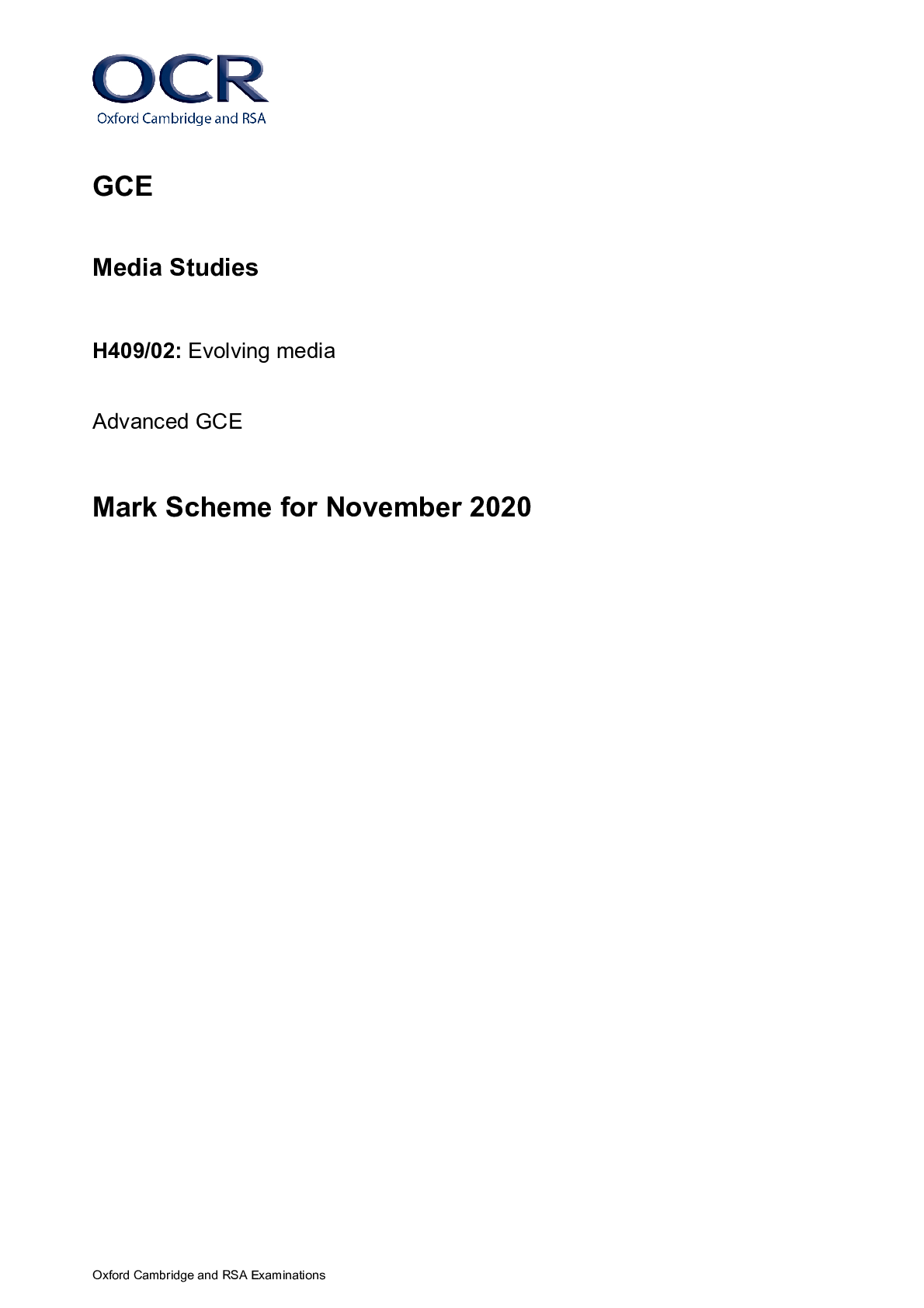
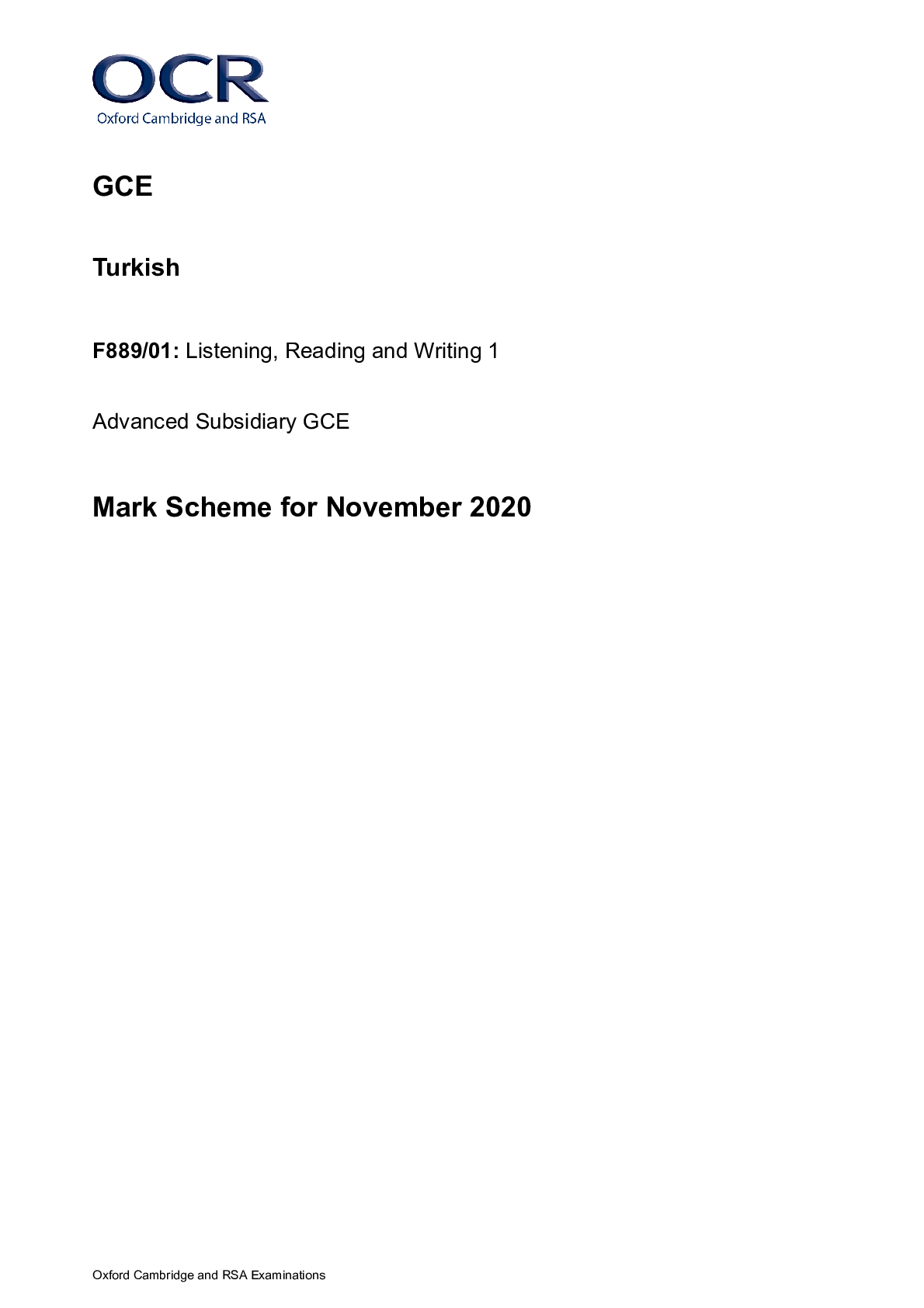
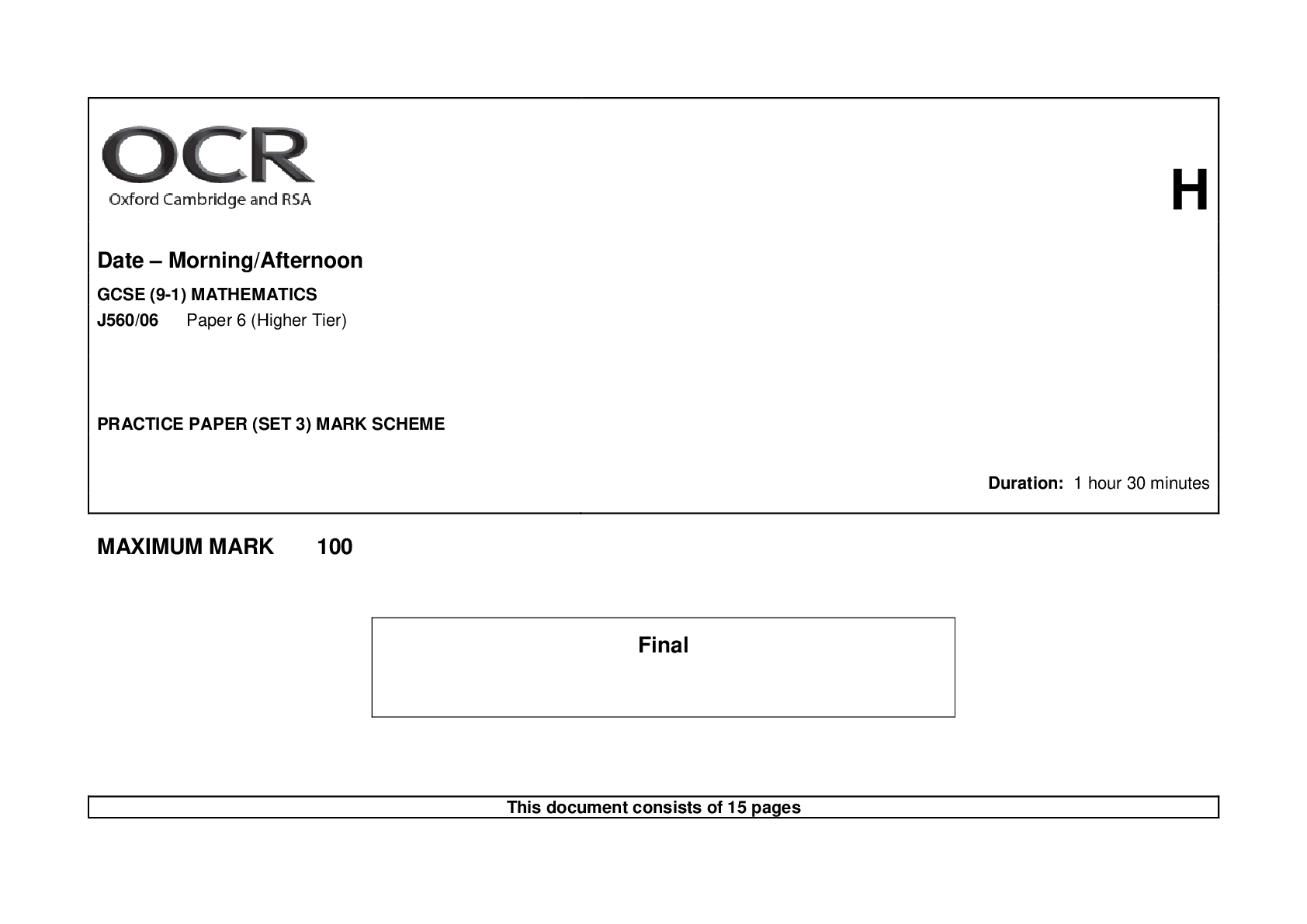


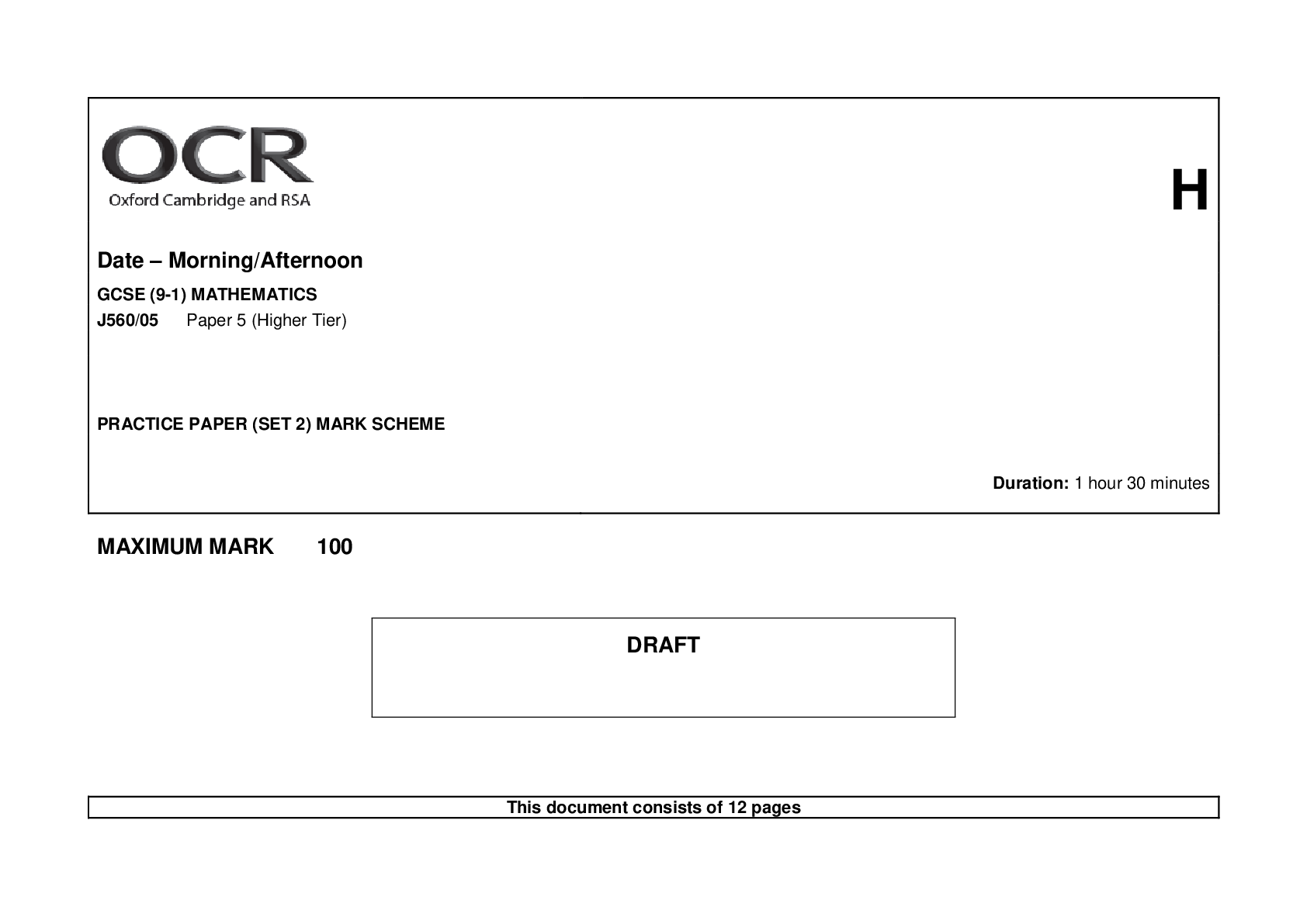
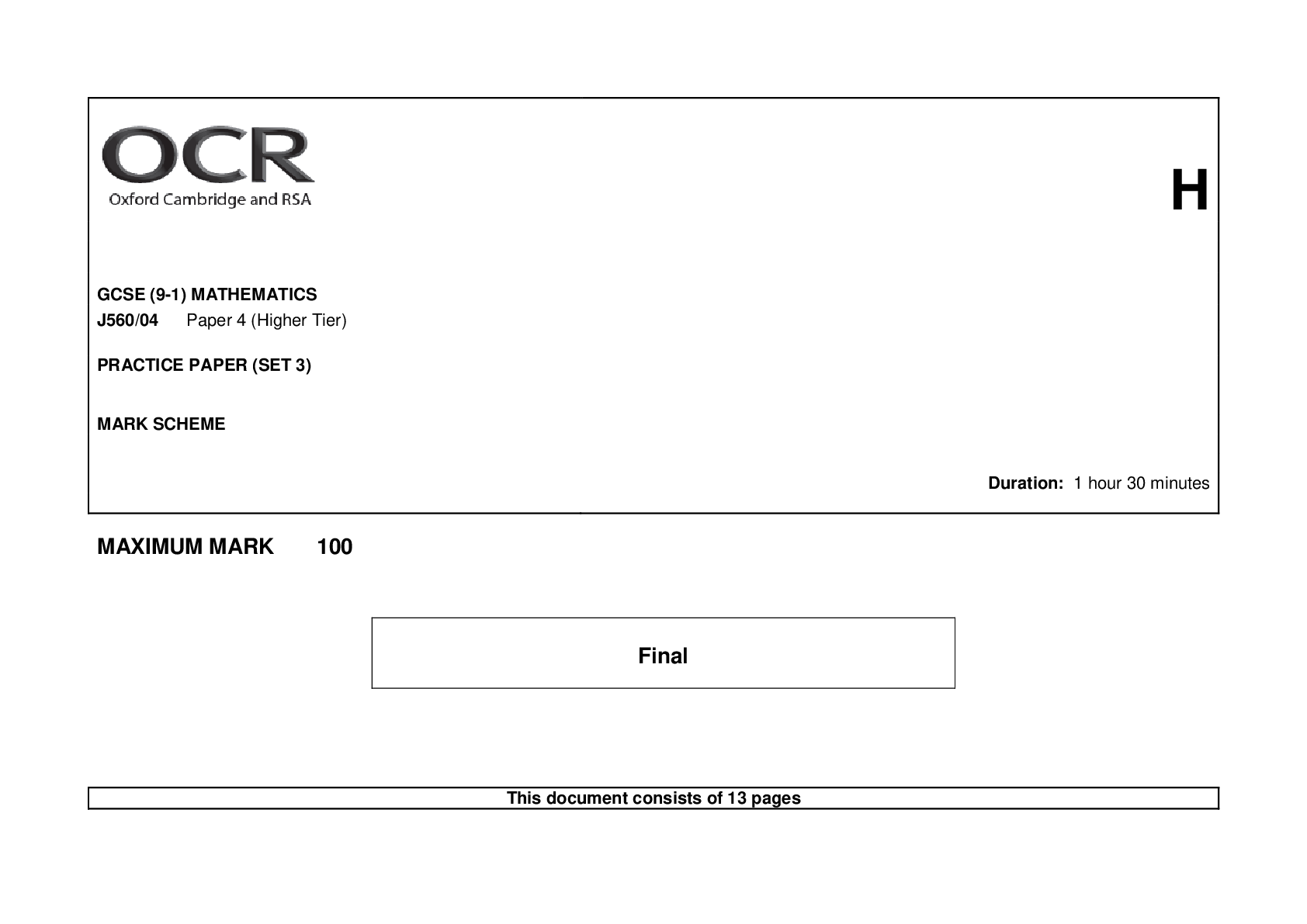



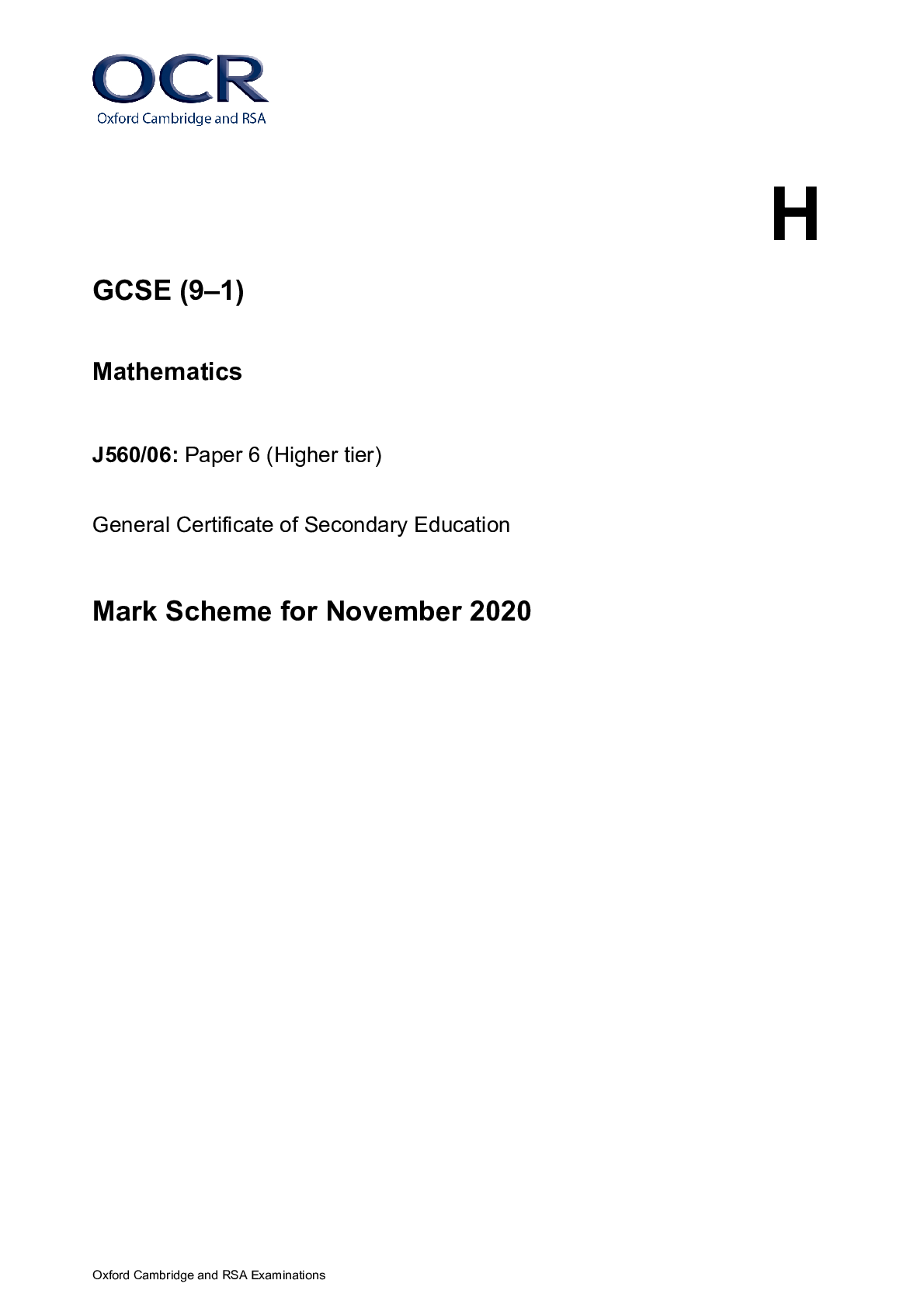
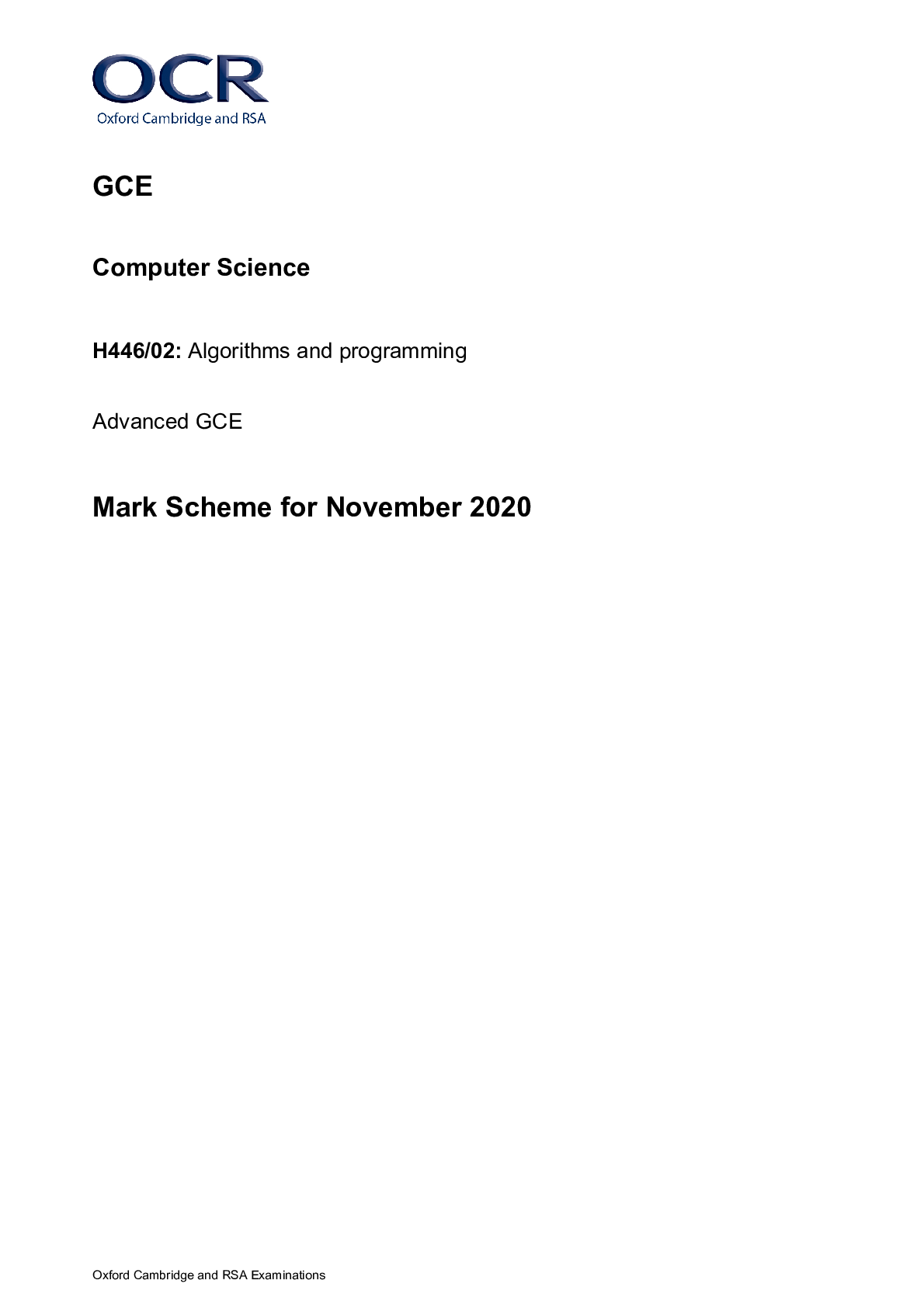
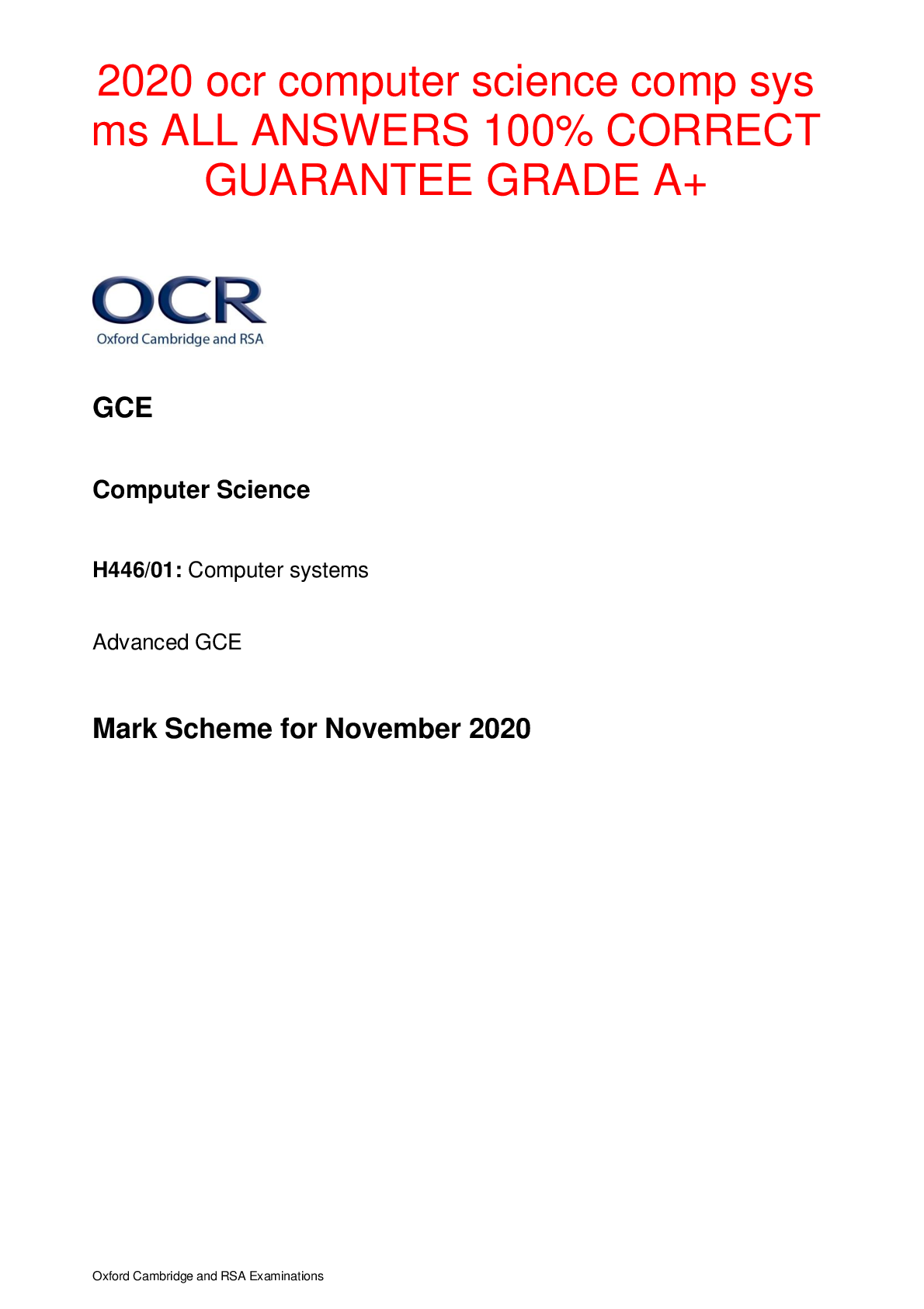
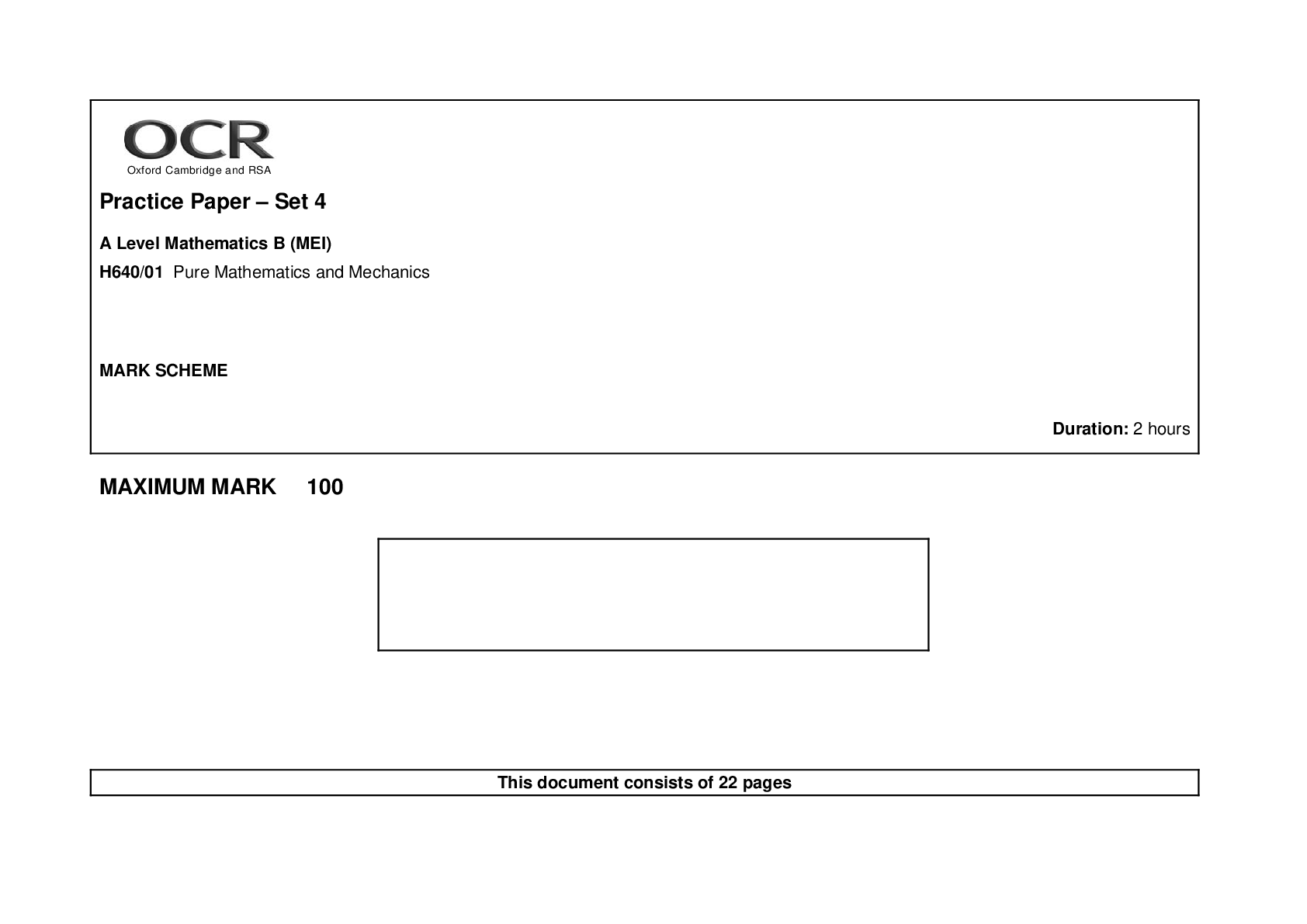
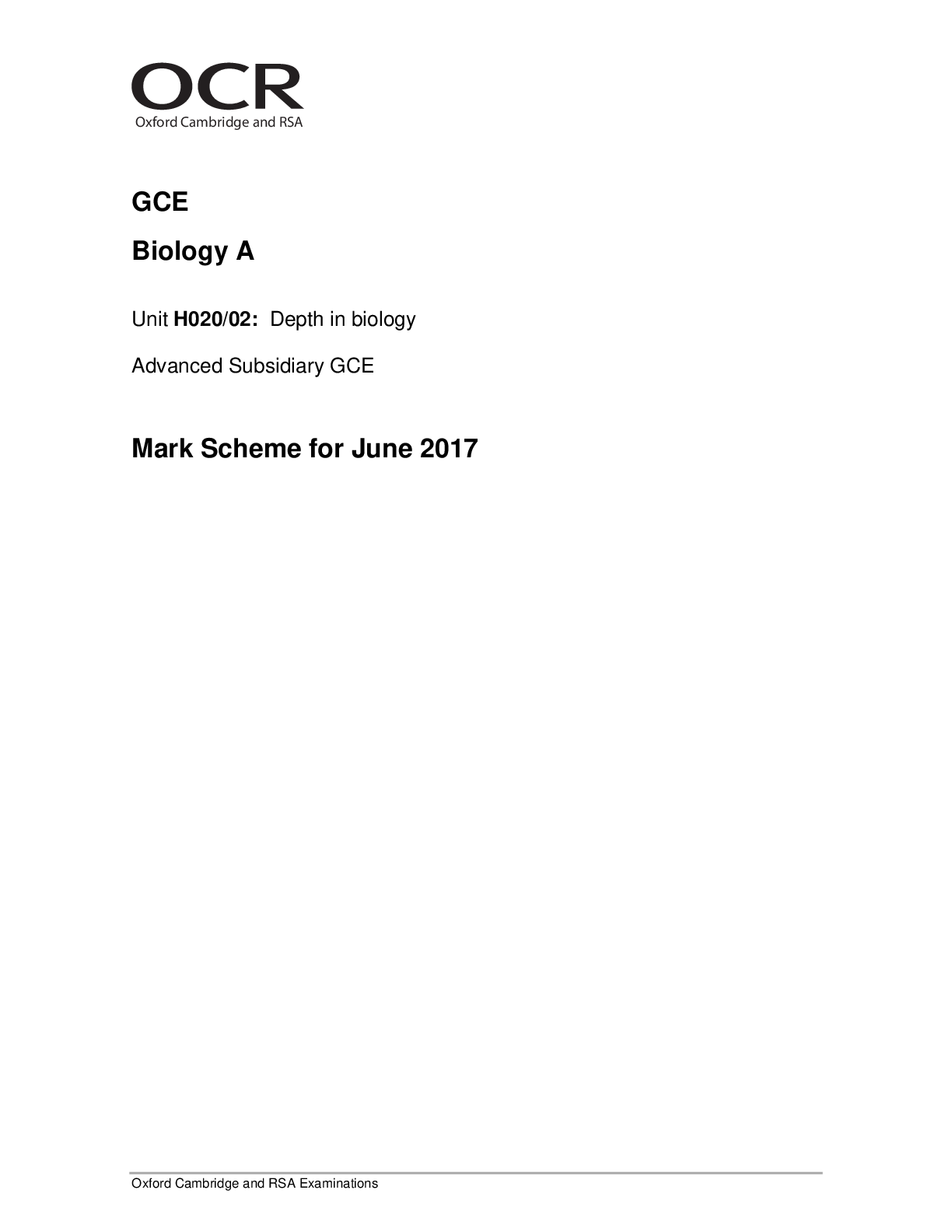


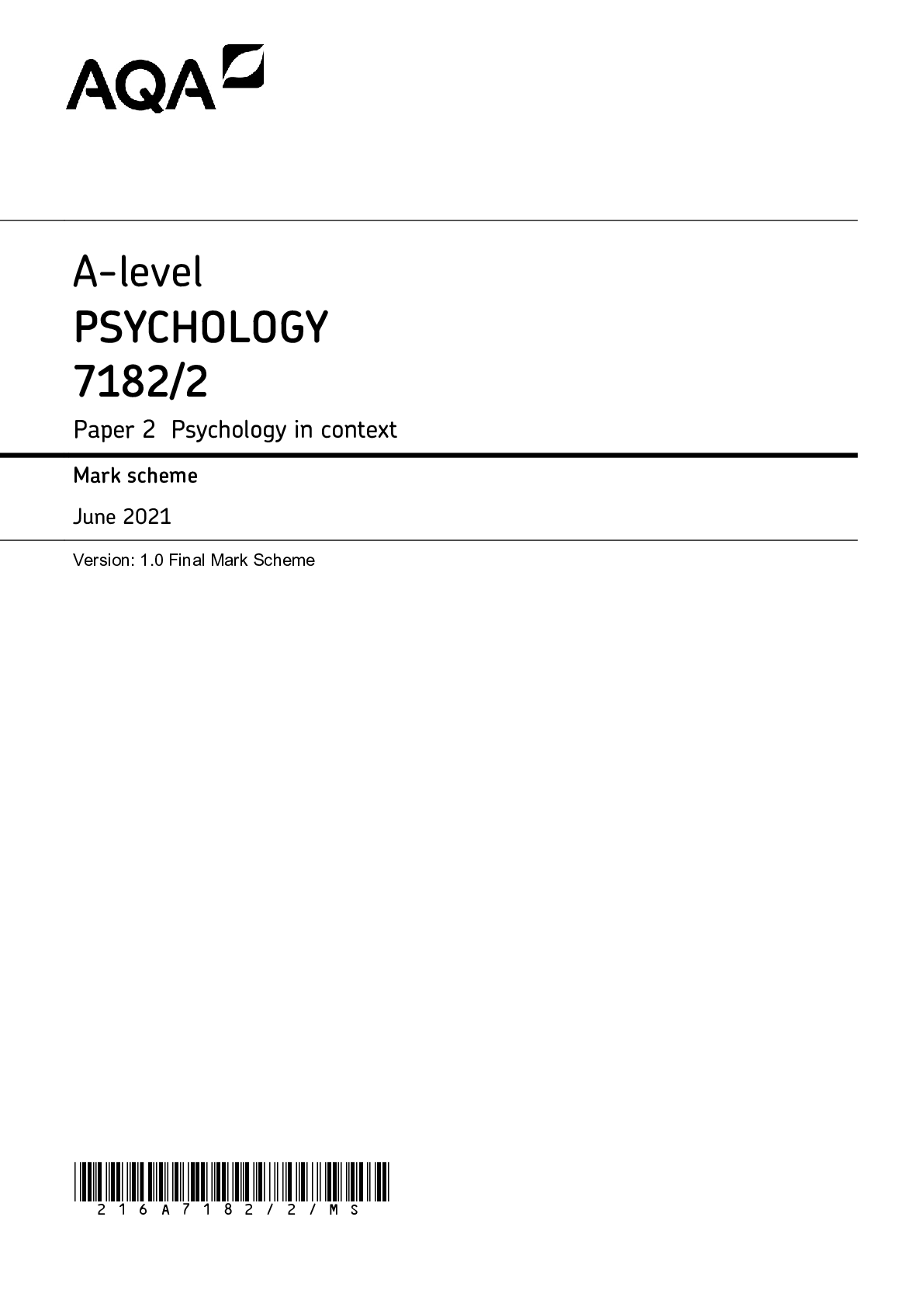
.png)
